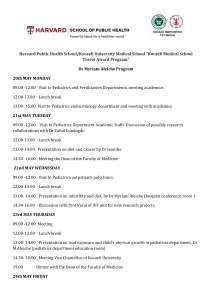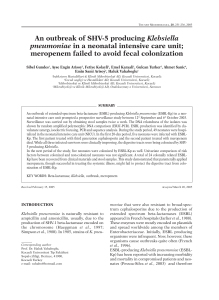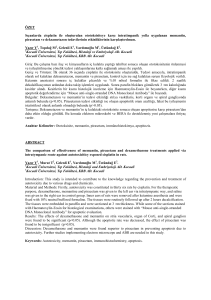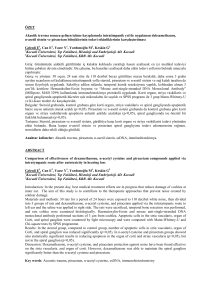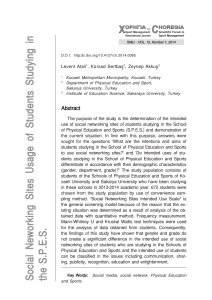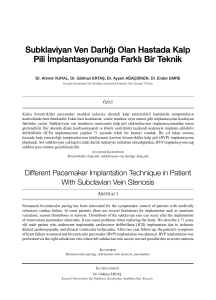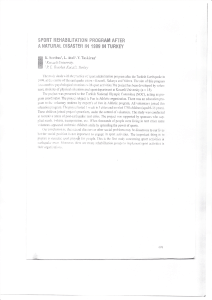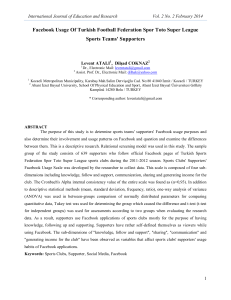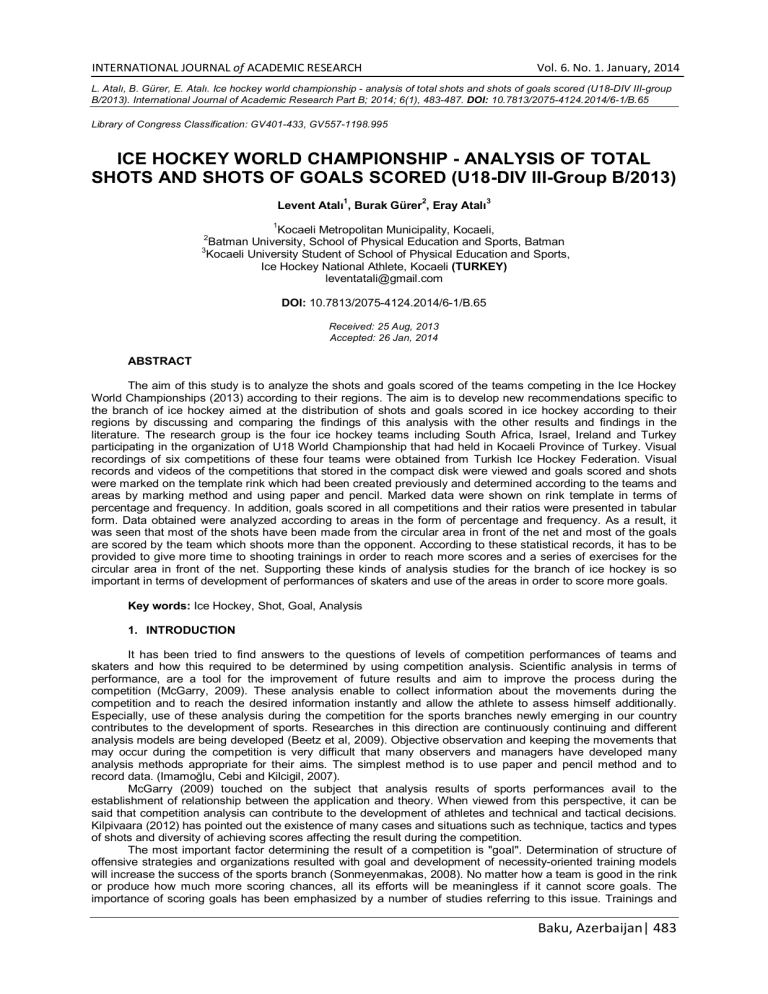
INTERNATIONAL JOURNAL of ACADEMIC RESEARCH
Vol. 6. No. 1. January, 2014
L. Atalı, B. Gürer, E. Atalı. Ice hockey world championship - analysis of total shots and shots of goals scored (U18-DIV III-group
B/2013). International Journal of Academic Research Part B; 2014; 6(1), 483-487. DOI: 10.7813/2075-4124.2014/6-1/B.65
Library of Congress Classification: GV401-433, GV557-1198.995
ICE HOCKEY WORLD CHAMPIONSHIP - ANALYSIS OF TOTAL
SHOTS AND SHOTS OF GOALS SCORED (U18-DIV III-Group B/2013)
1
2
Levent Atalı , Burak Gürer , Eray Atalı
3
1
Kocaeli Metropolitan Municipality, Kocaeli,
Batman University, School of Physical Education and Sports, Batman
3
Kocaeli University Student of School of Physical Education and Sports,
Ice Hockey National Athlete, Kocaeli (TURKEY)
[email protected]
2
DOI: 10.7813/2075-4124.2014/6-1/B.65
Received: 25 Aug, 2013
Accepted: 26 Jan, 2014
ABSTRACT
The aim of this study is to analyze the shots and goals scored of the teams competing in the Ice Hockey
World Championships (2013) according to their regions. The aim is to develop new recommendations specific to
the branch of ice hockey aimed at the distribution of shots and goals scored in ice hockey according to their
regions by discussing and comparing the findings of this analysis with the other results and findings in the
literature. The research group is the four ice hockey teams including South Africa, Israel, Ireland and Turkey
participating in the organization of U18 World Championship that had held in Kocaeli Province of Turkey. Visual
recordings of six competitions of these four teams were obtained from Turkish Ice Hockey Federation. Visual
records and videos of the competitions that stored in the compact disk were viewed and goals scored and shots
were marked on the template rink which had been created previously and determined according to the teams and
areas by marking method and using paper and pencil. Marked data were shown on rink template in terms of
percentage and frequency. In addition, goals scored in all competitions and their ratios were presented in tabular
form. Data obtained were analyzed according to areas in the form of percentage and frequency. As a result, it
was seen that most of the shots have been made from the circular area in front of the net and most of the goals
are scored by the team which shoots more than the opponent. According to these statistical records, it has to be
provided to give more time to shooting trainings in order to reach more scores and a series of exercises for the
circular area in front of the net. Supporting these kinds of analysis studies for the branch of ice hockey is so
important in terms of development of performances of skaters and use of the areas in order to score more goals.
Key words: Ice Hockey, Shot, Goal, Analysis
1. INTRODUCTION
It has been tried to find answers to the questions of levels of competition performances of teams and
skaters and how this required to be determined by using competition analysis. Scientific analysis in terms of
performance, are a tool for the improvement of future results and aim to improve the process during the
competition (McGarry, 2009). These analysis enable to collect information about the movements during the
competition and to reach the desired information instantly and allow the athlete to assess himself additionally.
Especially, use of these analysis during the competition for the sports branches newly emerging in our country
contributes to the development of sports. Researches in this direction are continuously continuing and different
analysis models are being developed (Beetz et al, 2009). Objective observation and keeping the movements that
may occur during the competition is very difficult that many observers and managers have developed many
analysis methods appropriate for their aims. The simplest method is to use paper and pencil method and to
record data. (Imamoğlu, Cebi and Kilcigil, 2007).
McGarry (2009) touched on the subject that analysis results of sports performances avail to the
establishment of relationship between the application and theory. When viewed from this perspective, it can be
said that competition analysis can contribute to the development of athletes and technical and tactical decisions.
Kilpivaara (2012) has pointed out the existence of many cases and situations such as technique, tactics and types
of shots and diversity of achieving scores affecting the result during the competition.
The most important factor determining the result of a competition is "goal". Determination of structure of
offensive strategies and organizations resulted with goal and development of necessity-oriented training models
will increase the success of the sports branch (Sonmeyenmakas, 2008). No matter how a team is good in the rink
or produce how much more scoring chances, all its efforts will be meaningless if it cannot score goals. The
importance of scoring goals has been emphasized by a number of studies referring to this issue. Trainings and
Baku, Azerbaijan| 483
INTERNATIONAL JOURNAL of ACADEMIC RESEARCH
Vol. 6. No. 1. January, 2014
studies aimed on scoring goals is one of the most important subjects on which many studies have been
performed in this issue for ice hockey (Cited by: Malkia, 2006; Westerlund 1992; Teivainen and Vahteristo 1995;
Sumkin and Vuorinen 2005). By considering the ultimate goal of the forward line is to produce the necessary
positions in order to score goal also in ice hockey such as the same with many sports, the team is required to
establish its play in the offensive zone in order to produce the necessary positions and to score goals. The most
important factors affecting to score are the position of the skater who will score points, the area, the direction of
the movement, speed and the technique. Malkia (2006) and Winkler (1993) touched on the subject that match
analysis are an integrative situation for the evaluation of general performance. They pointed out that many
parameters composing football have to be determined while evaluating the performance and have to be recorded
on a regular basis after examining according to their study on football.
Coaches can follow up the overall condition of their teams, individual performances of their players by
benefiting from match analysis studies specific to the branch based on scientific data and should use these
results and findings in favor of their teams and players (Gönener, Sertbas and Atali, Ozturk and Taskiran, 2004).
It has been seen that scientific methods for the movements in sports have been used for different sports in
recent times in addition to the other important contributions of sports sciences. Aims of increasing performance
and success lie at the bottom of these researches (McGarry, 2009). When viewed from these angles, this
research is considered to contribute to ice hockey. The fact that there are not so much researches in the branch
of ice hockey which is an emerging sports branch in our country further increases the importance of the research.
The analysis of shots and goals scored of teams participating in Ice Hockey World Championships (2013)
according to the areas and zones of these shots is considered to contribute to technical and tactical performances
of athletes and individual performances in the branch of Ice Hockey.
The aim of this study is to analyze the shots and goals scored of the teams competing in the Ice Hockey
World Championships (2013) according to their regions. The aim is to develop new recommendations specific to
the branch of ice hockey aimed at the distribution of shots and goals scored in ice hockey according to their
regions by discussing and comparing the findings of this analysis with the other results and findings in the
literature.
2. METHOD
2.1. Research Group
The research group is the four ice hockey teams including South Africa, Israel, Ireland and Turkey
participating in the organization of U18 World Championship that had held in Kocaeli Province of Turkey. The
competitions of the organization were held in Kocaeli Ice Rink (Kocaeli B.B. Ice Arena) and six competitions took
place between the teams. A total of 2571 spectators watched the competitions (www.iihf.com).
2.2. Data Collection
Visual recordings of six competitions of these four teams were obtained from Turkish Ice Hockey
Federation. Visual records and videos of the competitions that stored in the compact disk were viewed and goals
scored and shots were marked on the template rink which had been created previously and determined according
to the teams and areas by marking method and using paper and pencil.
Fig. 1. Zones of Goals and Shots Template (Mensonen and Salo,2008)
Determination of the distribution of shots and goals scored according to the areas was made by Menson
and Salo (2008) previously according to determined the areas and zones of Ice Hockey (Figure 1). An Ice Hockey
484 | PART B. SOCIAL SCIENCES AND HUMANITIES
www.ijar.eu
INTERNATIONAL JOURNAL of ACADEMIC RESEARCH
Vol. 6. No. 1. January, 2014
rink is divided into six parts. These parts are named as the crease area (1), the area at the face- off circle (2), the
big circle (3), inside the attacking triangle (4) outside the attacking triangle (5) and behind the blue line (6).
2.3. Analysis of Data
Goals scored and shots were determined with marking method by using paper and pencil on the created
rink template according to the areas and zones. Marked data were shown on rink template in terms of percentage
and frequency. In addition, goals scored in all competitions and their ratios were presented in tabular form and
data obtained were analyzed according to areas in the form of percentage and frequency.
3. FINDINGS
Fig. 2. Distribution of Shots at the World Championships according to the Area
As illustrated in Figure 2, considering the distribution of total shots according to the zones, it can be seen
that most of shots were sent from the area at the face-off circle with no.2 with 299 and have a ratio of 35,46% and
the least shots were sent from the area named behind the blue line with no.6 with 36 and have a ratio of 4,27%.
Fig. 3. Distribution of Goals scored at the World Championships according to the Areas
As illustrated in Figure 3, considering the distribution of total goals according to the zones, it can be seen
that most of shots were sent from the crease area with no.1 with 36 and have a ratio of 62,06% and the least
shots were sent from the area named inside the attacking triangle with no.4 with 1 and have a ratio of 1,72%.
Baku, Azerbaijan| 485
INTERNATIONAL JOURNAL of ACADEMIC RESEARCH
Vol. 6. No. 1. January, 2014
Table 1. Distribution of Shots and Goals Scored based on teams at the World Championships
Teams
Israel
South Africa
Turkey
Ireland
Total
Goals Scored
25
% 43,10
14
% 24,13
13
% 22,41
6
% 10,34
58
100,00
Shots
312
216
188
127
843
% 37,01
% 25,62
% 22,30
% 15,06
100,00
As illustrated in Table 1, considering total goals scored, Most of the goals were scored by Israeli team with
25 and have ratio of 43,10% and most of shots were sent by the same team with 312 and have a ratio of 37,01%.
By contrast with this situation least of the goals were scored by Irish team with 6 and have a ratio of 10,34% and
the least of shots were sent by the same team with 127 and have a ratio of 15,06%. In addition, the average of
goals per competition is 9,7 for the organization in which 6 competitions were held and 58 goals scored in total.
4. DISCUSSION
Shots and goals scored of the teams competing in the Ice Hockey World Championships (2013) have
been tried to be analyzed according to the areas and zones in this study. Recommendations specific to the
branch of ice hockey were developed aimed at the distribution of shots and goals scored according to the areas
and zones by discussing and comparing the findings obtained as a result of analysis performed in this study with
the other results in the literature in this section.
It was observed that the highest shot ratio was seen at the areas including area of the face-off circle (2)
that forms a circular area in front of the net, the crease area (1) and the big circle (3) respectively according to the
analysis performed during the study. The prominent characteristic of these areas is the fact that the player who
will shoot is able to see the net obviously. The most important factors affecting to score are the position of the
skater who will score points, the area, the direction of the movement, speed and the technique (Malkia, 2006).
According to the analysis of the areas and zones of goals scored, respectively, it was seen the most of the
goals scored were sent from the crease area (1), the area at the face-off circle (2) and the big circle (3). According
to a study conducted by Mensoken and Salo (2008), it was determined that the most of the goals scored were
sent from the crease area (1), the area at the face-off circle (2) and the big circle (3) respectively at the 2005
World Championships and the 2006 Olympic Games. And also an another study conducted by Sumkin and
Vourinen (2005) about the 2003 World Championships confirms these findings. It can be said that the zonal
distribution of the shots which are resulted as goals mostly and these findings show a similarity. Mikkola (1986)
has identified the most suitable area for shooting. According to him, the goal scoring possibility increases when
the shot is sent from a circular area in the offensive zone. In addition, Kostka (1971) approached to the event of
scoring from a different viewpoint during his studies about scoring and he used a triangular area in order to define
and describe the most suitable area for shooting. At the same time, he stated and argued that the midpoint of the
area seven meters from the net is the most suitable point for the final shot. (Malkia, 2006).
It was seen that the team which shot more than all the others is the team which scored more than all the
other teams and the team which shot less than all the others was the least scoring team of the organization. In
addition, the average of goals per competition was determined as 9,7 for the organization. It was determined that
the average of goals per competition was 5,4 at the 2006 Olympic Games and 5,2 at the 2005 World
Championships which had been examined by Saarinen, Mensonen and Small (2009).
As a result, it was seen that most of the shots have been made from the circular area in front of the net
and most of the goals are scored by the team which shoots more than the opponent. According to these statistical
records, it has to be provided to give more time to shooting trainings in order to reach more scores and a series of
exercises for the circular area in front of the net. Supporting these kinds of analysis studies for the branch of ice
hockey is so important in terms of development of performances of skaters and use of the areas in order to score
more goals.
REFERENCES
1. Beetz M., Hoyningen-Huene N., and Kirchlechner B., Gedikli S.,Siles F., Duruş M., Lames M., (2009)
ASPOGAMO: Automated Sports Game Analysis Models. In International Journal of Computer
Science in Sport, 8.
2. Gönener A., Sertbaş K., ve Atalı L., Öztürk M., Taşkıran, Y. (2004) Buz Hokeyi Gençler Türkiye
Şampiyonası Play Off Final Müsabakasındaki Bazı Hücum Parametrelerinin İncelenmesi. Performans
Dergisi, 3.
3. İmamoğlu O., Çebi M., Kılcıgil E. (2007) 2006 FIFA Dünya Futbol Kupasındaki Gollerin Teknik ve
Taktik Kriterlere Göre Analizi. SPORMETRE Beden Eğitimi ve Spor Bilimleri Dergisi, (4) 157-165.
4. Kilpivaara P. (2012) Ice Hockey Goaltending: Physiological Loading and Analysis. Unpublished
Master Thesis, Department of Biology and Physical Activity, University of Jyvaskyla, Finnish.
5. Malkia J. (2006) Comparison Between 5 On 5 and 4 On 4 Playing Formats in Ice Hockey.
Unpublished Master Thesis, HAAGA University of Applied Sciences Vierumaki Sports Institute.
Helsinki.
6. McGarry T. (2009). Applied and Theoretical Perspectives of Performance Analysis in sport: Scientific
issues and Challenges. International Journal of Performance Analysis of Sport, 9, 128-140.
486 | PART B. SOCIAL SCIENCES AND HUMANITIES
www.ijar.eu
INTERNATIONAL JOURNAL of ACADEMIC RESEARCH
Vol. 6. No. 1. January, 2014
7. Mensonen J., Salo O. (2008) Effective Offensive Play. Scoring Analysis of the 2005 World
Championships and the 2006 Olympics. Unpublished Master Thesis, Haaga-Helia University of
Applied Sciences, Finnish.
8. Saarinen M., Mensonen J., ve Small D. (2009) Goal Analysis: World Championships 2005, Olympic
Games, www.iihf.com
9. Sönmeyenmakas A., (2008) UEFA Şampiyonlar Liginde Atılan Gollerin Analizi, Unpublished Master
Thesis, Trakya Üniversitesi, Sağlık Bilimleri Enstitüsü, Beden Eğitimi ve Spor Anabilim Dalı, Yüksek
Lisans Tezi, s.2
10. Sumkin S., Vuorinen J. (2005) Scoring in ice hockey. Case: Scoring analysis of the WCS 2003.
Unpublished Master Thesis, Haaga- Helia University of Applied Sciences, Finnish.
11. Winkler W., (1993) Computer Controlled Assesmentand Video Technology for The Diagnosis of a
Player’s Performance in Soccer Training. Scienceand Football, E & F.N. Spon, p. 363-367.
12. www.iihf.com (2013).
Baku, Azerbaijan| 487

